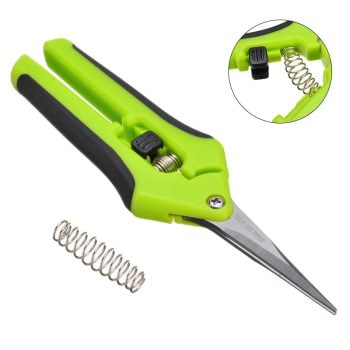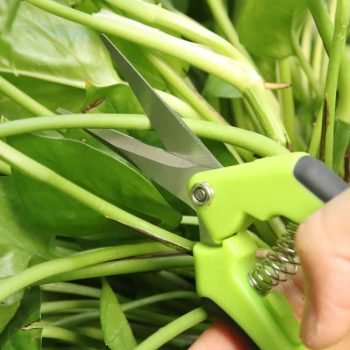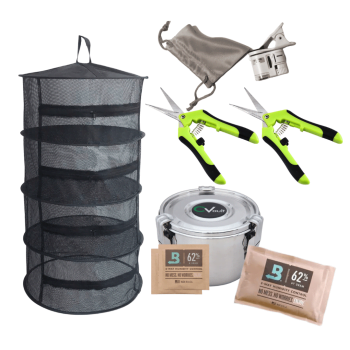Pruning and defoliating cannabis plants is an important technique employed by cultivators to optimize plant health and promote larger yields. The careful removal of specific plant growth, including leaves and branches, can enhance light penetration, increase airflow, and redirect nutrients to essential areas of the plant, ultimately resulting in a more productive and potent harvest.
In this comprehensive guide, we will look into what, why, when, and how of pruning and defoliating your cannabis plants.
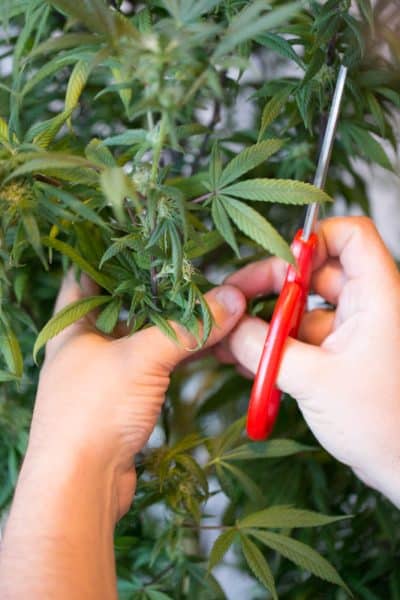
What is Defoliation and Pruning?
Defoliation is like giving your cannabis plants a little trim of their fashionable green outfits. Specifically, it’s the practice of selectively removing certain leaves from your plants. We’re talking about those big, fan-like leaves that soak up sunlight like a sponge. Defoliation aims to thin out the foliage, particularly around the lower parts of your cannabis plants.
Picture it like tidying up your garden. By removing some of these leaves, you’re allowing more light to reach the lower branches and bud sites. It’s like making sure every plant in your garden gets a front-row seat to the sunlight show. This technique helps your plant focus its energy on the areas that matter most – where those lovely buds will soon blossom.
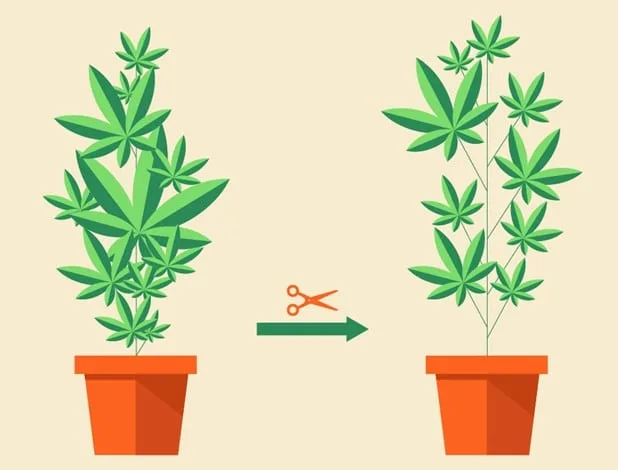
Adopted and edited from this source: https://growdiaries.com/journal/is-it-safe-to-defoliate-cannabis
Pruning: Pruning is like giving your cannabis plant a bit of a haircut, but instead of scissors, you’ll need pruning shears. It involves the precise cutting away of specific branches and shoots. The goal here is to shape your plant’s growth and optimize its structure.
By strategically snipping away unwanted branches or shoots, you’re helping your cannabis plant grow in the direction you desire. Pruning also helps remove any dead or damaged parts, keeping your plant looking sharp and healthy.

Defoliation vs. Pruning — Understanding the Differences:
Defoliation is like giving the cannabis plant a light haircut by removing some leaves. Pruning is a bit more intense; it’s like giving the plant a haircut and trimming some branches. Both techniques aim to help the plant grow better, but they’re done in slightly different ways.
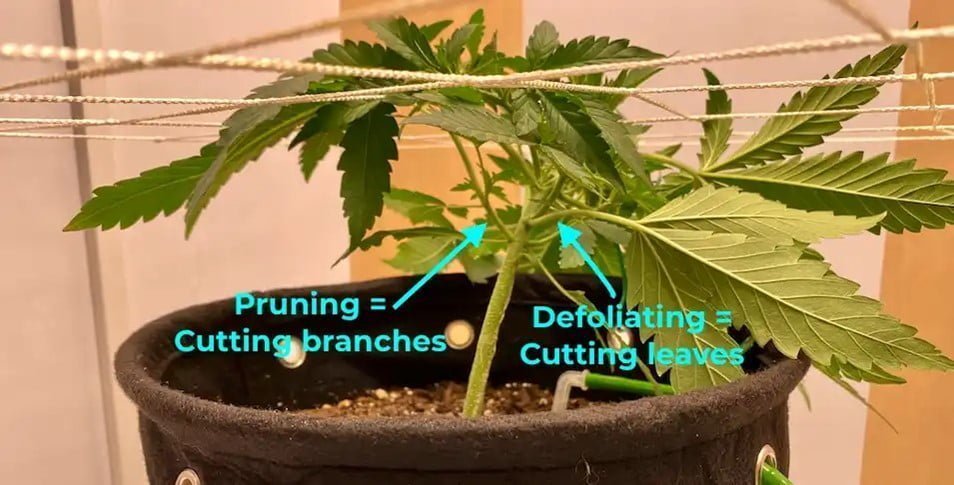
Adopted and edited from this source: https://budtrainer.com/blogs/learntogrow/defoliation
Which Leaves and Branches Should I Cut Off?
Focus on trimming or removing small branches and leaves near the bottom of the plant during pruning. These lower leaves often receive less light and produce smaller buds. When defoliating, target larger fan leaves that shade bud sites or block airflow. Prioritize those that hinder light penetration to lower parts of the plant.
How Many Branches and Leaves Should I Remove?
Start conservatively, especially if you’re new to pruning and defoliation. Remove a small number of branches or leaves initially, and then observe how your plant responds. Gradually increase the amount as needed while monitoring your plant’s health. Avoid overdoing it, as excessive removal can stress the plant and harm its growth. The specific quantity will depend on your plant’s size and vigor, so it’s a process best tailored to each individual plant’s needs.
Why Defoliate and Prune Cannabis?
Defoliation is like a secret sauce to cannabis cultivation. These techniques involve the selective removal of leaves and branches to achieve several key objectives. Here are some generalized purposes that why you should care:
- Improved Light Distribution: Those lush fan leaves may be captivating, but they can also cast shade on your lower branches and bud sites. By selectively removing some of these leaves, you’re giving every part of your plant a fair share of the light buffet. More light equals more energy for growth and bud production. Don’t remove all your fan leaves while the plant is still young. These leaves are crucial for photosynthesis needed for small plants to grow fast.
- Enhanced Airflow: Cannabis plants, like us, need a bit of breathing space. When you trim away excess foliage, you’re creating a more open and airy environment around your plants. This reduces the risk of nasty surprises like mold, mildew, and sneaky pests that thrive in stagnant air.
- Efficient Nutrient Usage: With fewer leaves to feed, cannabis plants can direct their resources more efficiently. The result? Healthier, more robust growth and, ultimately, higher yields.
Why Prune Cannabis Plants?
Pruning is like giving your cannabis plants a personalized haircut. Here’s why it’s a game-changer:
- Shape and Structure: Imagine crafting a piece of art. Pruning allows you to shape your plant’s growth, directing it where you want it to go. It’s like giving your plant a roadmap, so it knows exactly which direction to grow in. This not only makes your garden look tidier but also optimizes its overall structure.
- Increased Yield: Pruning isn’t just about aesthetics; it’s a yield booster. By selectively removing certain branches or buds, you encourage the plant to put its energy into growing larger, healthier buds. You’re telling your cannabis plant to focus on quality over quantity.
- Healthier Plant: Just like a spa day for your plant, pruning helps remove dead or diseased parts. Be sure to remove any dead leaves near your plant, they can attract bugs and mold.. This promotes overall plant health and vitality.
When to Defoliate Cannabis Plants?
Knowing when to defoliate your cannabis plants is like picking the perfect time to catch a wave – timing is everything. Let’s dive into it Reefertilizer style:
- Early Vegetative Stage: Think of this stage as the time when your little cannabis seedlings are growing their first true leaves and building their foundation. During this phase, defoliation should be light if at all. Topping at the third node is all you really need to do for now..
- Late Vegetative Stage: As your cannabis plants evolve from youngsters to adolescents, they can handle a bit more defoliation action. Start some selective leaf removal, especially targeting those lower leaves that are far from the action and in the shade. These big fan leaves aren’t as effective at photosynthesis, so they’re prime candidates for trimming. Limit yourself to removing only a handful of leaves at a time to prevent stressing your plants. By now, your plants should be well on their way to creating a robust framework.
- Early Flowering Stage: This is the stage when your cannabis plants shift gears and begin the aromatic journey of flowering. It’s also the time to tread lightly with defoliation. While you can still remove a few large leaves that are blocking light, be cautious not to overdo it. Your plants are now focused on bud production, and removing too many leaves can stress them out.
How to Defoliate and Prune Cannabis?
There are two famous techniques when it comes to defoliation and pruning cannabis plants:
1. Lollipopping
Lollipopping is a pruning technique used to create a well-manicured cannabis plant that resembles a lollipop, with a robust upper canopy and minimal lower growth. This technique is particularly useful for indoor growers aiming to maximize their bud production.
How to Lollipop Your Cannabis Plants
- Timing: Lollipopping is typically done during the early flowering stage. This is usually around the third or fourth week after the light schedule has been adjusted to 12 hours of light and 12 hours of darkness.
- Identify the Target Area: Begin by identifying the lower branches and leaves that are not receiving sufficient light or are unlikely to produce substantial buds. These are the parts you’ll be removing.
- Pruning: Using clean, sterilized pruning shears, carefully cut away the selected branches and leaves. Focus on the lowest 1/3 to 1/2 of the plant. Ensure your cuts are clean to minimize stress on the plant.
- Maintenance: As your plant continues to flower, periodically check for any new growth in the lollipop area. If you see small shoots or leaves emerging, remove them promptly to maintain the desired shape.
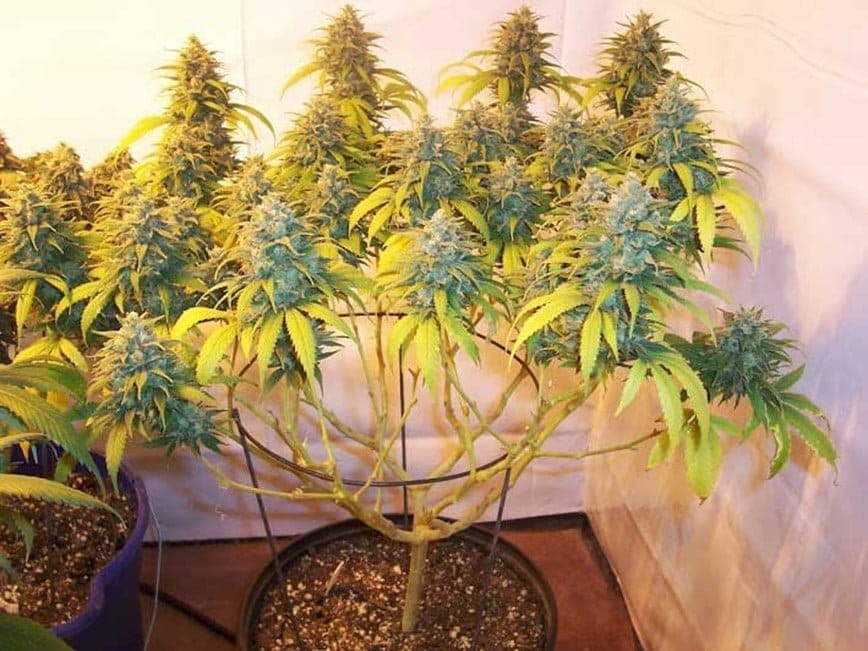
Adopted and edited from this source: https://www.growweedeasy.com/lollipopping-cannabis-tutorial
Benefit of Lollipopping
With fewer branches and leaves to support, your plant can allocate more resources to producing flowers, ultimately increasing yield and potency. These uppermost bud sites are also the biggest and most beautiful on the plant.
Get your Pruning / Defoliating Scissors today at discounted rates! These scissors are simple, cheap, and effective, making them the perfect tool for pruning your plants and trimming buds at harvest. The stainless steel blades are sharp and durable, and the spring makes trimming faster and easier. Buy Now
2. Topping and Fimming:
Topping and fimming are high-stress training techniques that involve strategically cutting the main stem or its tip to encourage the growth of multiple main colas, rather than a single dominant cola. These methods are excellent for promoting bushier growth and increasing your cannabis yield.
Topping:
- Timing: Topping is typically performed during the early vegetative stage when your plant has several sets of true leaves. It’s important to do this before your plant enters the flowering stage.
- Technique: Using clean scissors or pruning shears, cut the top of the main stem just above a node where new growth is emerging. This will stimulate the growth of two new main colas.
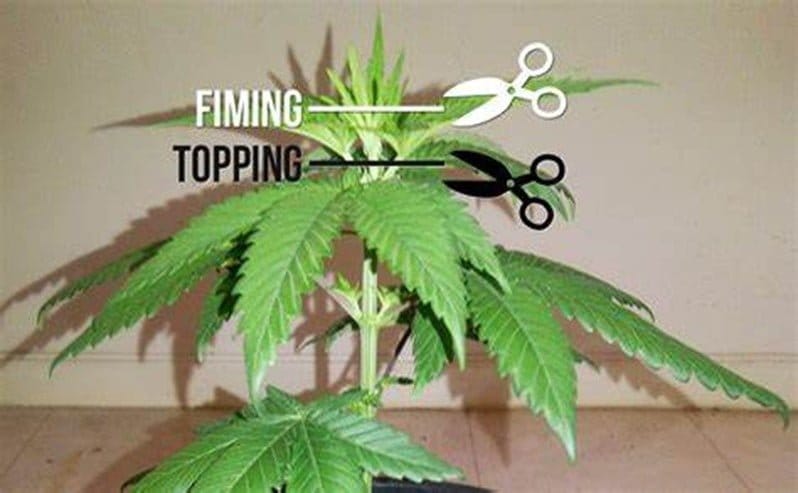
Adopted and edited from this source: https://easy420grow.com/topping-marijuana-to-increase-yield
Fimming:
- Timing: Fimming is also done in the early vegetative stage.
- Technique: Instead of cutting the main stem entirely like topping, fimming involves pinching or lightly cutting the top growth, leaving a small portion of it intact. This encourages the development of multiple new colas.
Benefits of Topping and Fimming:
- Increased Colas: Both techniques result in the growth of multiple main colas, increasing the potential bud sites and overall yield.
- Bushier Growth: Topped and fimmed plants tend to grow more bushy, which is beneficial for indoor growers with limited vertical space.
- Even Canopy: These techniques help create an even canopy, ensuring that all bud sites receive adequate light, resulting in more consistent bud development.
High-Stress Risks Associated with Pruning and Defoliation:
When you cut or remove leaves from cannabis plants, it can sometimes stress the plants out. This stress might make the plants grow more slowly, and it can also make them more vulnerable to diseases. So, it’s important to be careful and gentle when you trim the plants to avoid causing too much stress.These risks include:
- Photosynthetic Disruption: The removal of leaves during pruning and defoliation can disrupt the plant’s photosynthetic capacity, diminishing its ability to produce energy. This can lead to reduced growth rates and lowered overall plant vigor.
- Resource Reallocation: When pruning, resources within the plant must be redistributed. An imprecise approach can result in the misallocation of nutrients, diverting them away from flower development and essential growth processes.
- Vulnerability to Pathogens: Open wounds created by pruning and defoliation provide entry points for pathogens. Fungi, bacteria, and other harmful microorganisms can infect the plant, potentially causing diseases that compromise both yield and plant health.
- Stress-Induced Stunting: Excessive or poorly timed pruning can induce stress, leading to stunted plant growth. This can delay flowering and reduce the final harvest size.
- Extended Recovery Period: Cannabis plants require time to recover from the stress imposed by pruning and defoliation. During this recovery phase, growth can be temporarily slowed, extending the time it takes for the plant to reach its full potential.
- Genetic Variability: The response to pruning and defoliation can vary significantly among cannabis strains. Some strains may be more resilient, while others may be highly sensitive to stress, you may need different approaches based on genetic characteristics.
- Environmental Factors: High-stress risks can be exacerbated by environmental conditions. Extreme temperatures, humidity, or inadequate lighting can intensify the impact of pruning and defoliation on plant stress levels.
Counter the Risks of Pruning and Topping
When you trim cannabis plants, it can sometimes cause problems like slowing down their growth or making them sick. To avoid these issues, you need to be smart about how and when you trim. Make sure you don’t cut too much at once, and keep the plant in good conditions afterward. But when done right, trimming can help the plant grow better and produce more buds.
- Mitigating Photosynthetic Disruption: To counter the risk of photosynthetic disruption, it’s crucial to adopt a strategic approach to pruning and defoliation. Focus on removing only the lower, shaded, or damaged leaves while leaving a sufficient number of healthy leaves to maintain photosynthesis. Regularly monitor the plant’s foliage, ensuring that it always has enough greenery to sustain energy production.
- Optimizing Resource Reallocation: To prevent resource misallocation, carefully plan the timing and extent of pruning. Prioritize removing larger fan leaves and those competing for light rather than smaller, newer growth. This ensures that nutrients are redirected towards vital flower development and upper canopy growth. Regularly assess the plant’s nutrient needs and adjust your feeding regimen accordingly.
- Minimizing Vulnerability to Pathogens: To reduce the risk of pathogens entering through open wounds, employ sterile pruning tools and techniques. Immediately apply a protective substance, such as a fungicide or a natural plant sealant, to exposed areas after pruning. Maintain a clean and sanitized grow environment to minimize the presence of harmful microorganisms.
- Managing Stress-Induced Stunting: To avoid stress-induced stunting, schedule pruning during the vegetative growth phase and avoid excessive removal of foliage all at once. Gradual defoliation allows the plant to adapt and recover without severe shock. Ensure the plant receives optimal care, including proper nutrition, lighting, and temperature control to mitigate stress.
- Optimizing Recovery Period: To shorten the recovery period, provide the plant with ideal conditions post-pruning. This includes maintaining stable environmental parameters, providing balanced nutrition, and ensuring adequate light intensity.
- Addressing Genetic Variability: Acknowledge the genetic diversity among cannabis cultivars and seeds. Before implementing pruning and defoliation, research the specific characteristics of your cultivar to determine its stress tolerance. Some strains may benefit from more aggressive pruning, while others may require a gentler touch. Tailor your approach to suit the unique requirements of your chosen strain.
- Controlling Environmental Factors: To counteract environmental stressors, maintain a controlled indoor environment that mimics optimal outdoor growing conditions. Invest in quality lighting, climate control systems, and humidity monitoring. Prune and defoliate during periods of environmental stability to minimize additional stress on the plants.
Can I Prune and Defoliate an Autoflower?
You can prune and defoliate autoflowering cannabis but do so cautiously. Start in the early vegetative stage, be gentle to avoid stress, and monitor the plant closely. Autoflowers are more sensitive, so take a less-is-more approach, and adjust based on your plant’s response. Strain-specific research can help you tailor your approach effectively.
Benefits
Pruning and topping are essential cultivation techniques that can significantly benefit cannabis plants when employed correctly. Here are some of the advantages of these practices:
- Enhanced Light Penetration: Pruning and topping both play a critical role in optimizing the utilization of available light. By selectively removing leaves and branches that block light from reaching the lower parts of the plant, growers can ensure that more of the plant’s surface area receives sufficient light. This results in improved photosynthesis and overall growth, ultimately leading to higher yields.
- Increased Bud Development: Topping, in particular, triggers the plant to focus on developing multiple main colas rather than a single dominant one. This encourages the formation of larger, denser buds at each of these newly formed tops. Consequently, cannabis plants that have been topped tend to produce more substantial and higher-quality buds.
- Improved Airflow and Humidity Control: Pruning and topping contribute to better airflow within the canopy. Adequate airflow is essential for reducing humidity around the plant, which, in turn, lowers the risk of mold and mildew development. This improved airflow also promotes healthier plants and aids in the efficient exchange of gases, benefiting photosynthesis.
- Customized Growth: These techniques allow growers to customize the growth of their cannabis plants. Depending on the desired outcome, growers can choose to prune selectively to encourage vertical growth for tall strains or lateral growth for bushier plants. This flexibility enables growers to adapt their cultivation approach to suit the specific requirements of different strains.
- Optimized Resource Allocation: Pruning helps distribute resources, such as nutrients and water, more efficiently throughout the plant. By removing excess foliage and non-productive branches, resources are redirected to areas with active growth, including budding sites. This targeted resource allocation can lead to healthier, more robust plants and higher yields.
- Reduced Risk of Pest and Disease Infestations: Maintaining an open canopy through pruning and topping reduces the risk of pest and disease infestations. Improved visibility and accessibility make it easier for growers to spot and address issues promptly. Moreover, a well-ventilated canopy discourages the buildup of conditions favorable to pests and pathogens.
- Enhanced Control Over Growth: Pruning and topping offer growers greater control over the shape and size of their cannabis plants. This control is particularly valuable for growers with limited space or those growing indoors, where maintaining a compact, manageable canopy is essential. These techniques help prevent plants from becoming too tall or too bushy.
If you are looking for a deal on pruning and cannabis growing gear you can check out our Cannabis Harvest Bundle .
Which not only contains pruning and defoliating tools but also other items that will be helpful when harvesting your crop.
Contact us today to learn more and to order your products.
Mastering the art of pruning and defoliating cannabis plants is a pivotal skill for cultivators seeking to maximize yields and produce top-quality buds.
These techniques, when employed with precision and care, can unlock a world of benefits for your cannabis garden. From improved light distribution and enhanced airflow to efficient nutrient usage and plant health, the advantages are abundant.
However, it’s crucial to tread cautiously, considering the potential risks associated with high-stress situations for your plants. Ultimately, the decision to prune and defoliate should be a deliberate one, based on your specific goals and the unique characteristics of your cannabis cultivar and growing situation.
By balancing the art and science of these practices, you can take your cannabis cultivation to new heights, ensuring bountiful harvests and healthy, vibrant plants.
If you want to learn even more about growing good cannabis, we offer a free 40+ page guide full of images.
Now available on Amazon.
Sign up for our newsletter and download the digital copy today!
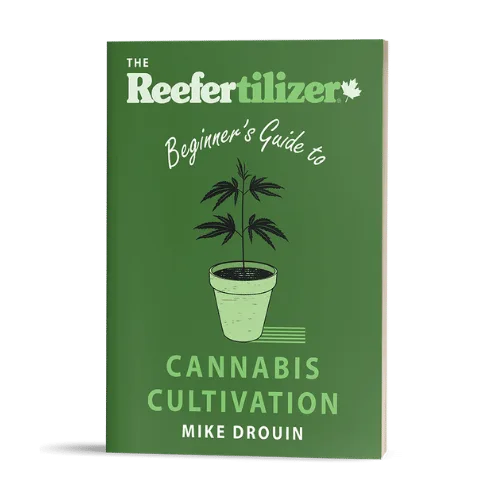
This guide will answer many questions about growing cannabis, like the following...
Selecting Seeds
Identify and Correct Problems
Maximize Yield
Much More...
Get a Chance to INSTANTLY WIN a Reefertilizer Nutrient Kit When You Sign Up.
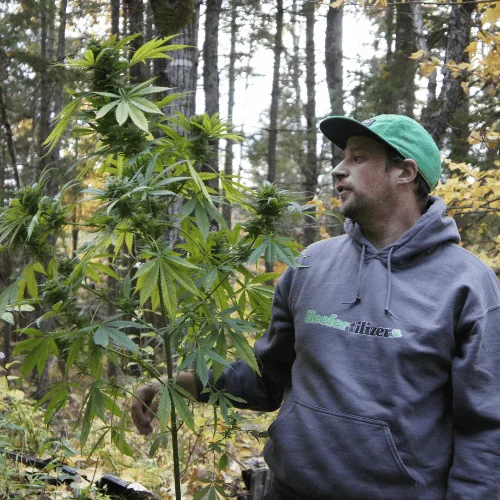
Mike Drouin is the co-founder of Reefertilizer. He’s an experienced craft cannabis grower and a writer of many articles regarding the process. Mike lives on Vancouver Island and enjoys cycling and camping and will sometimes combine the two.

